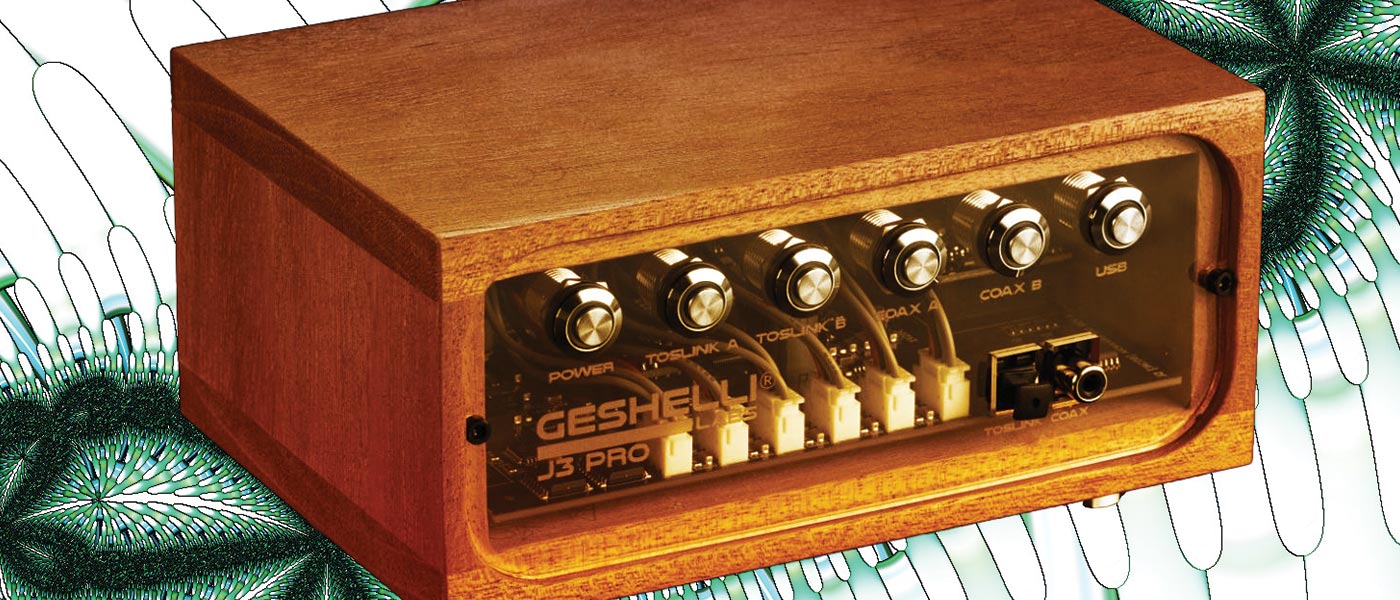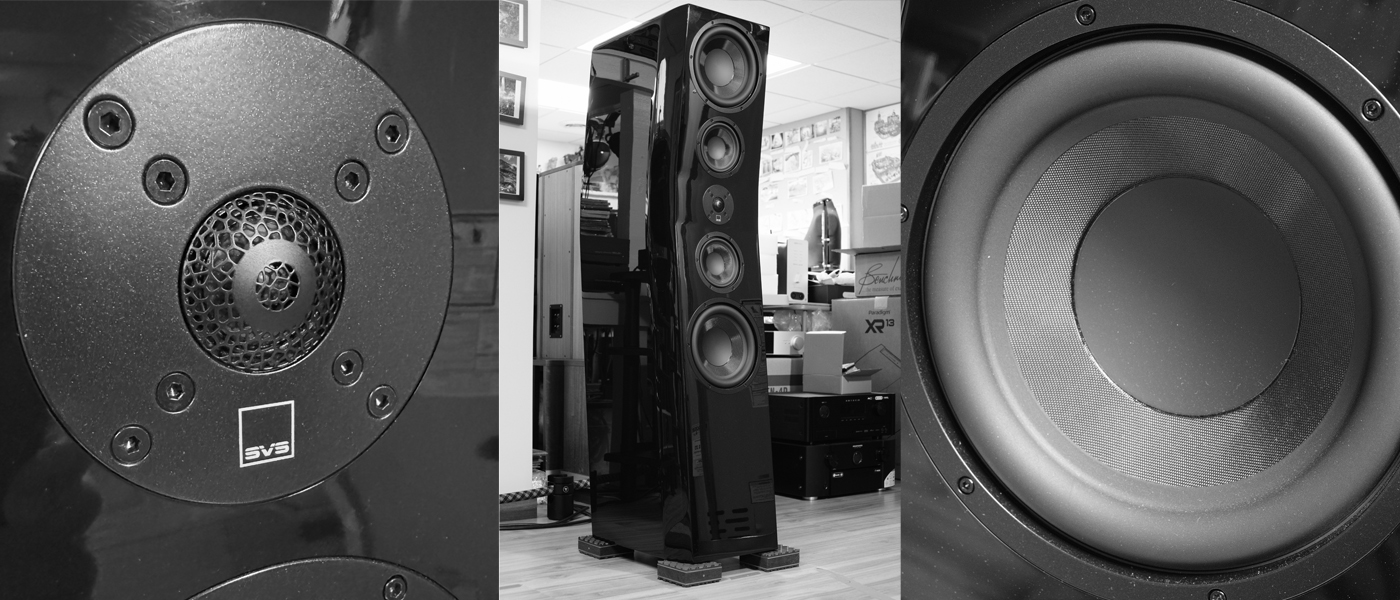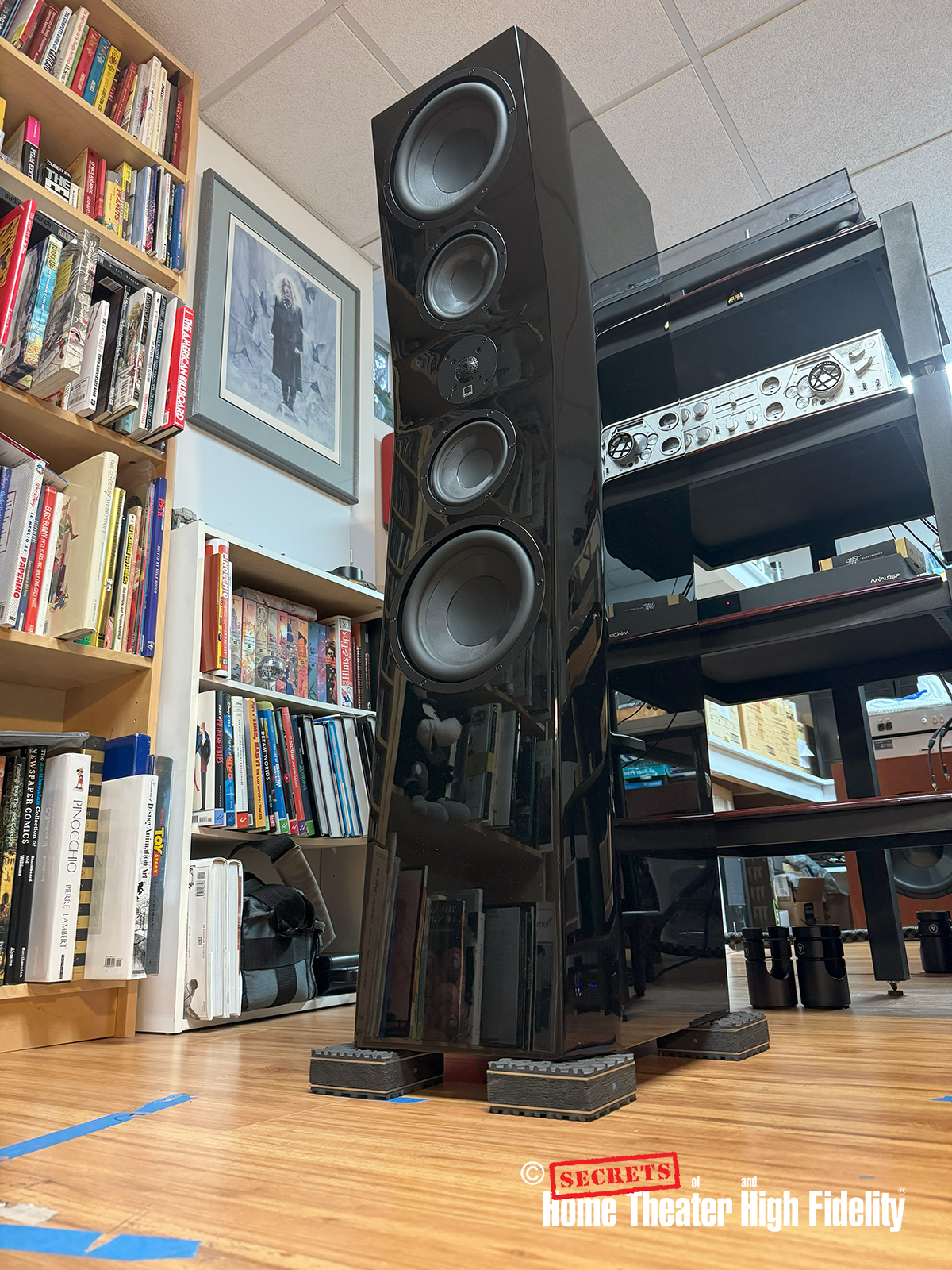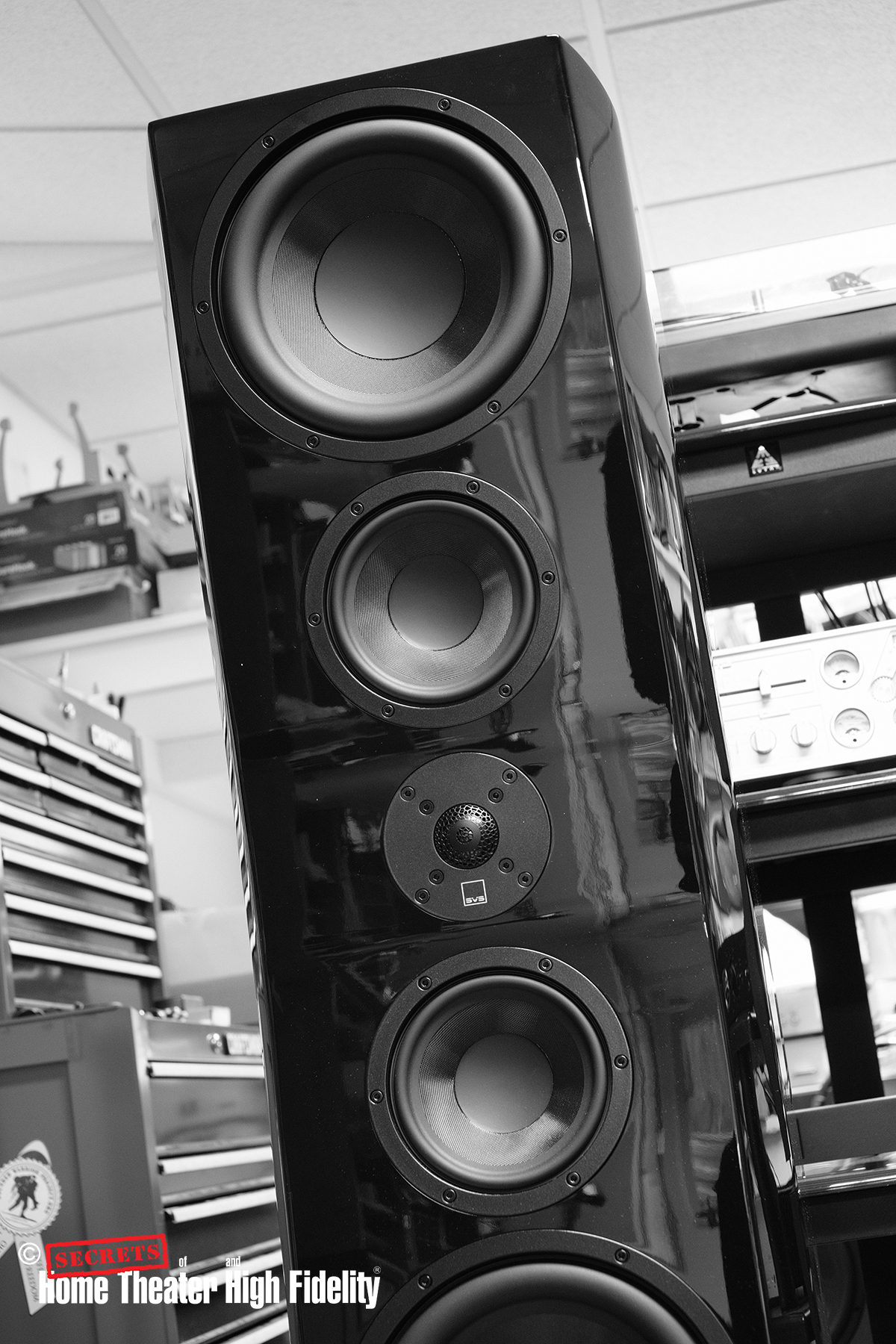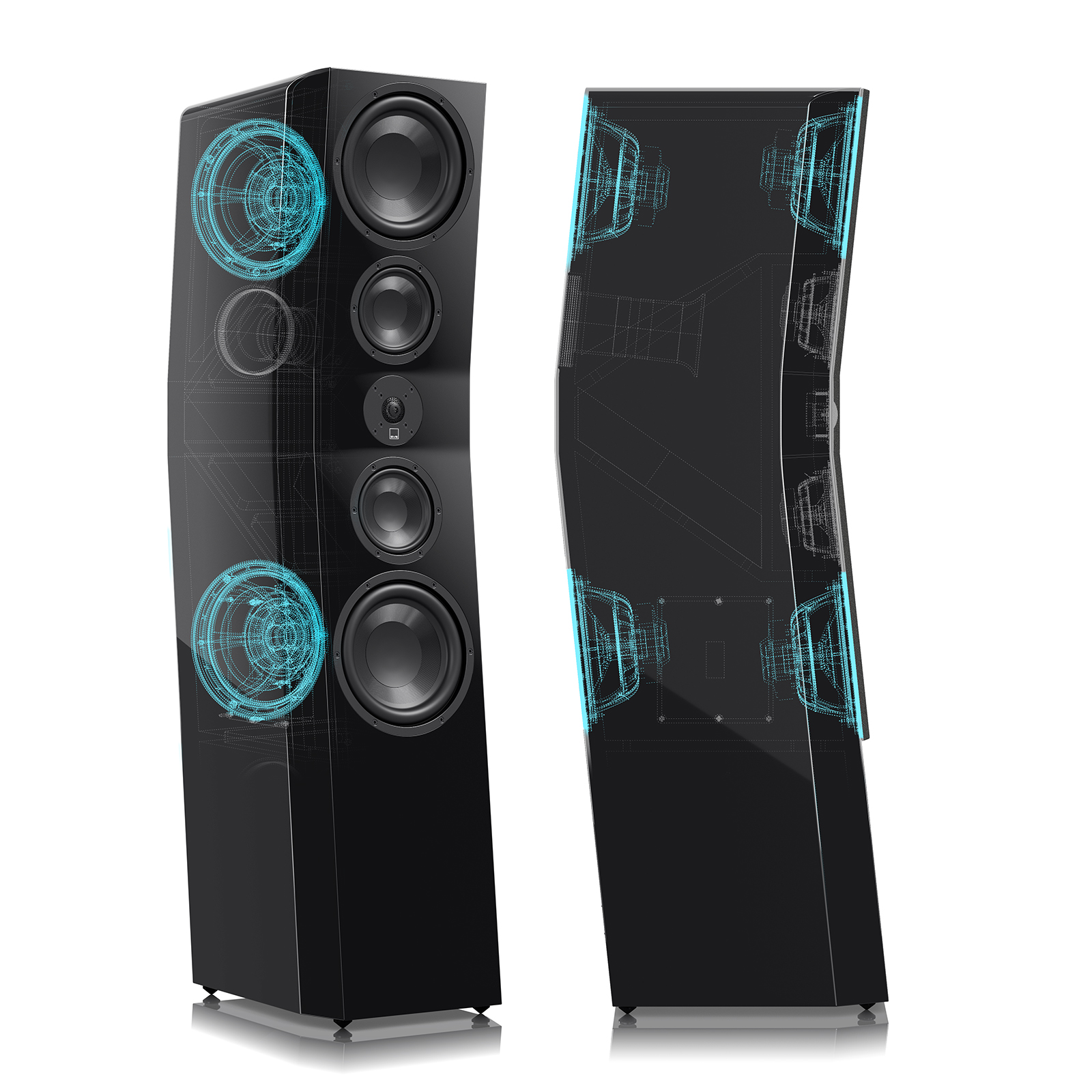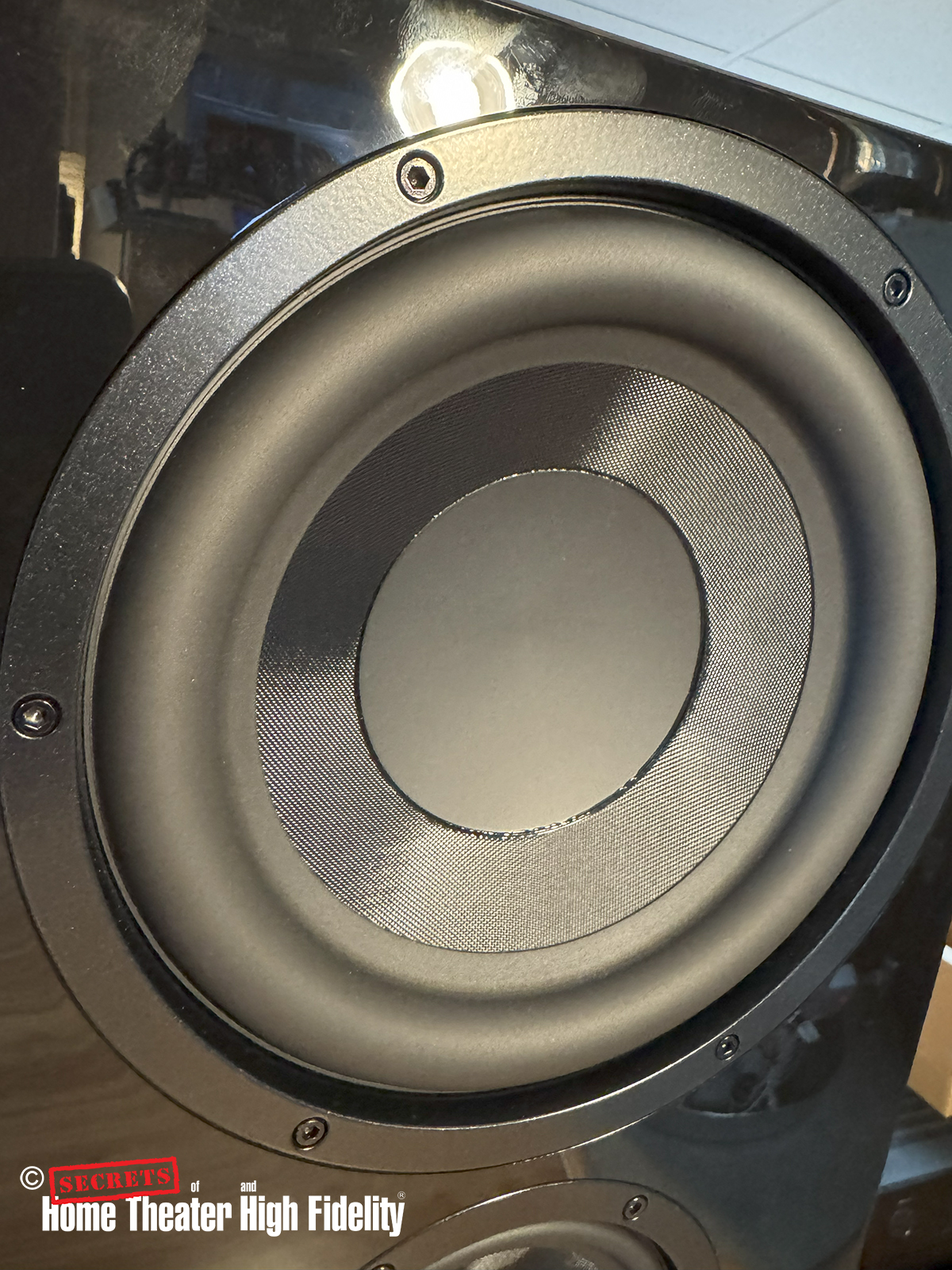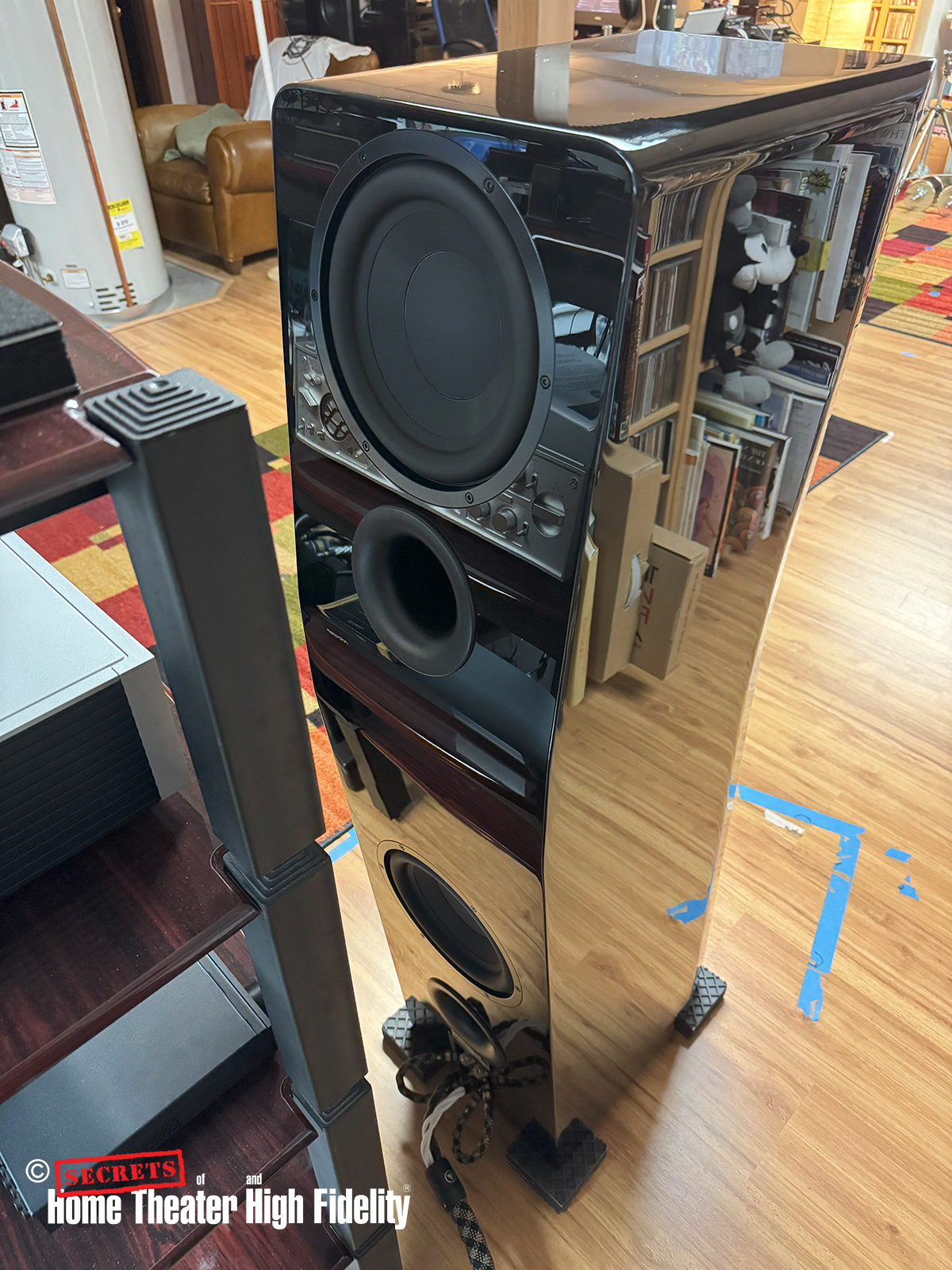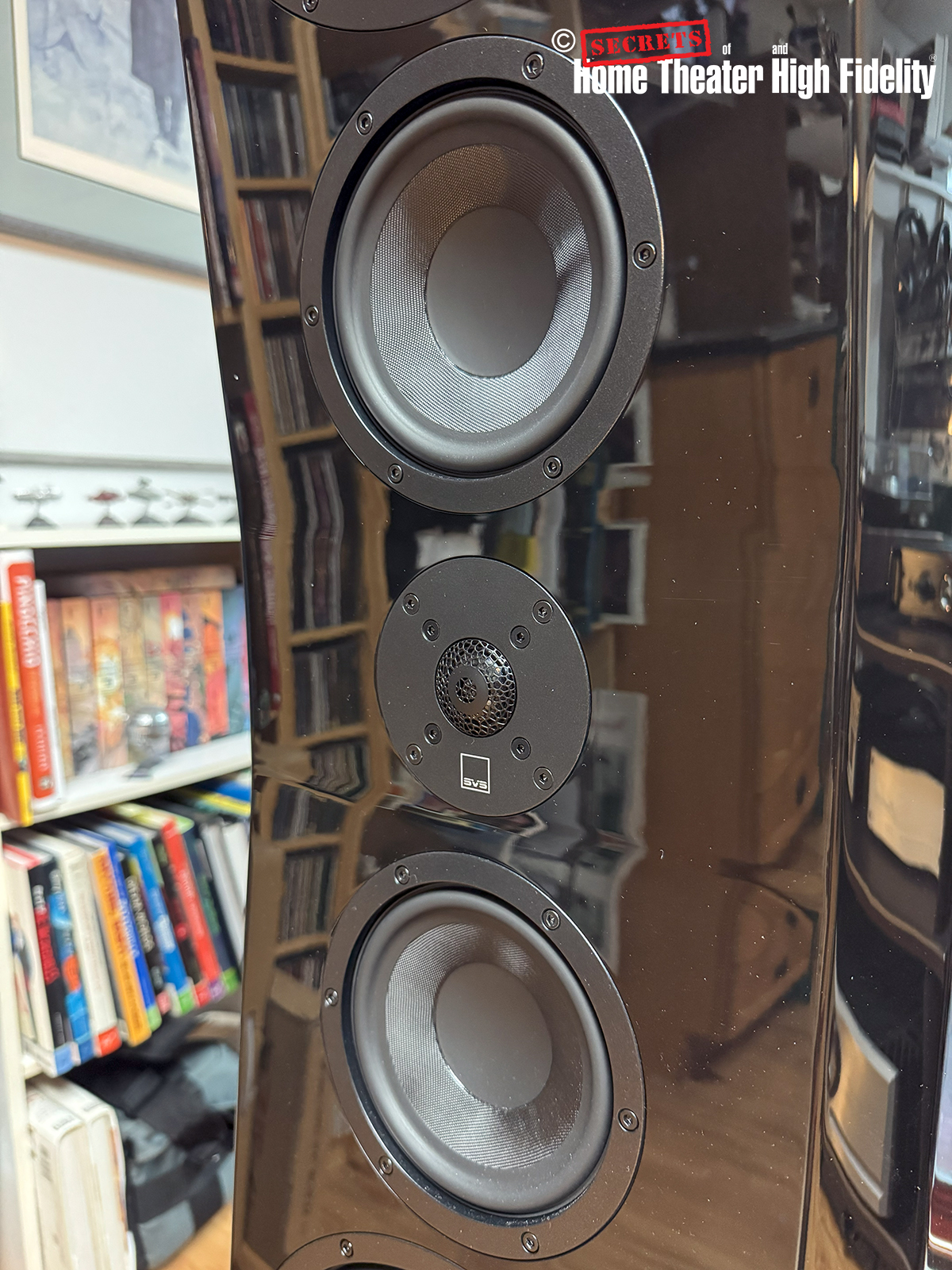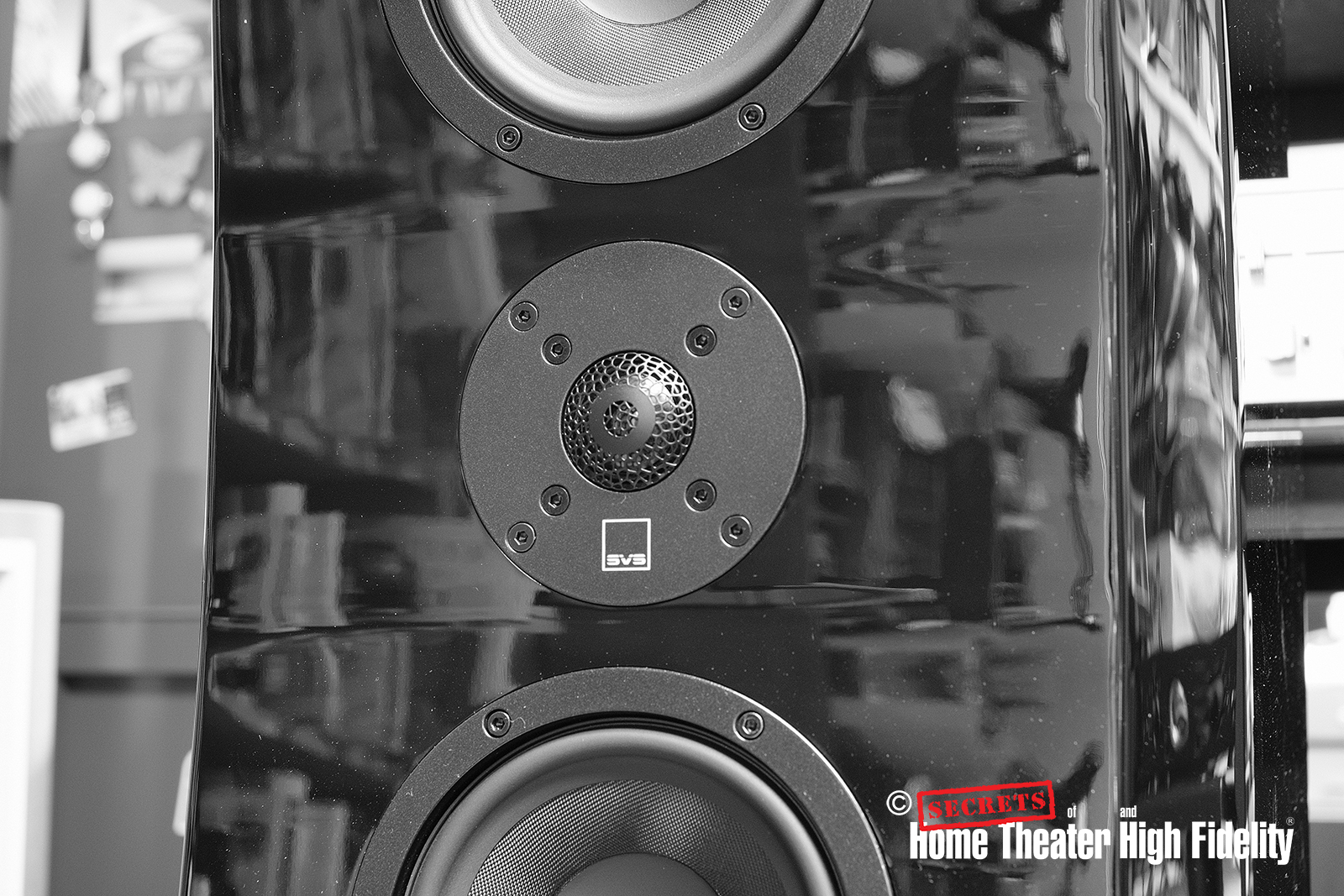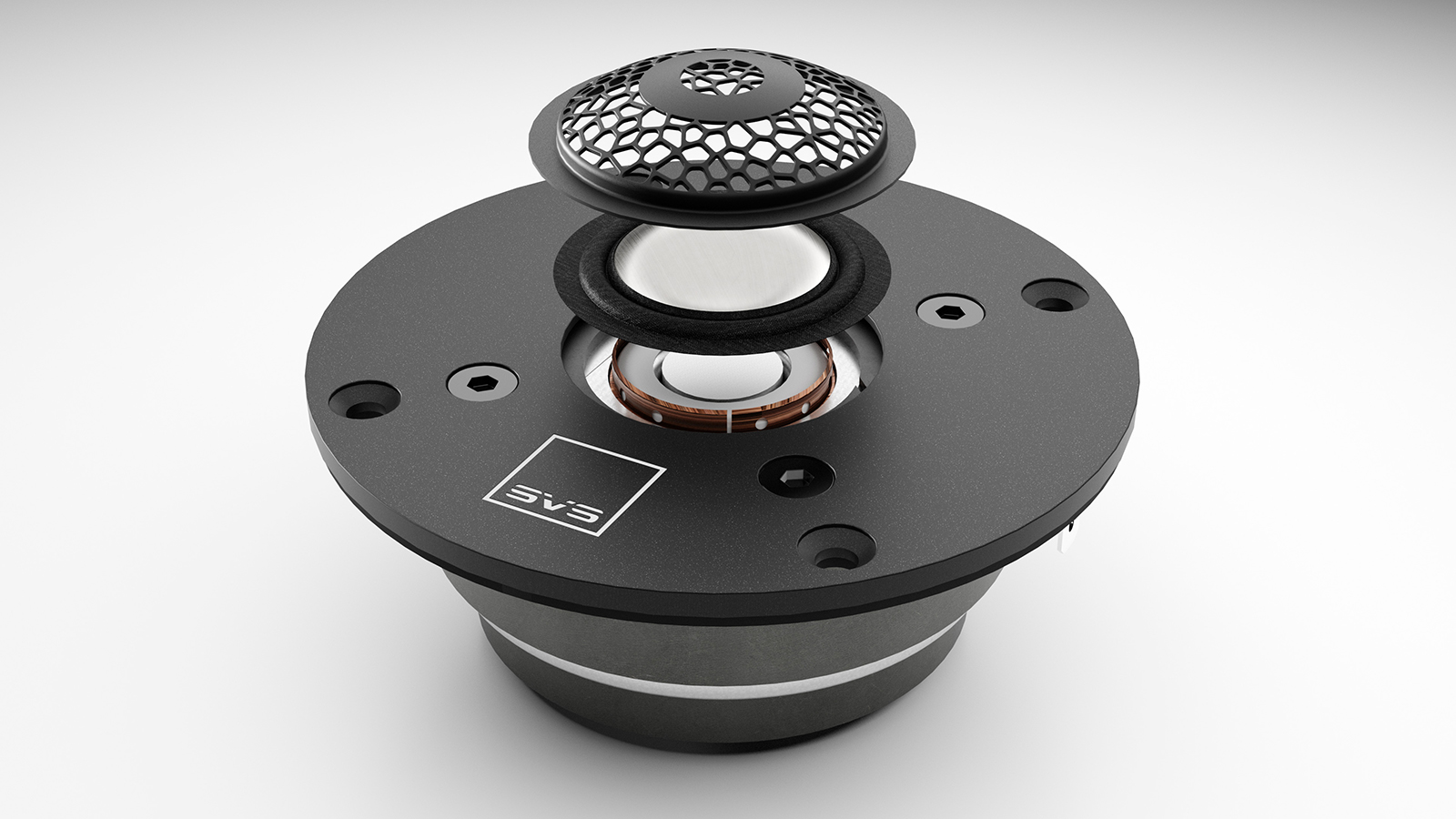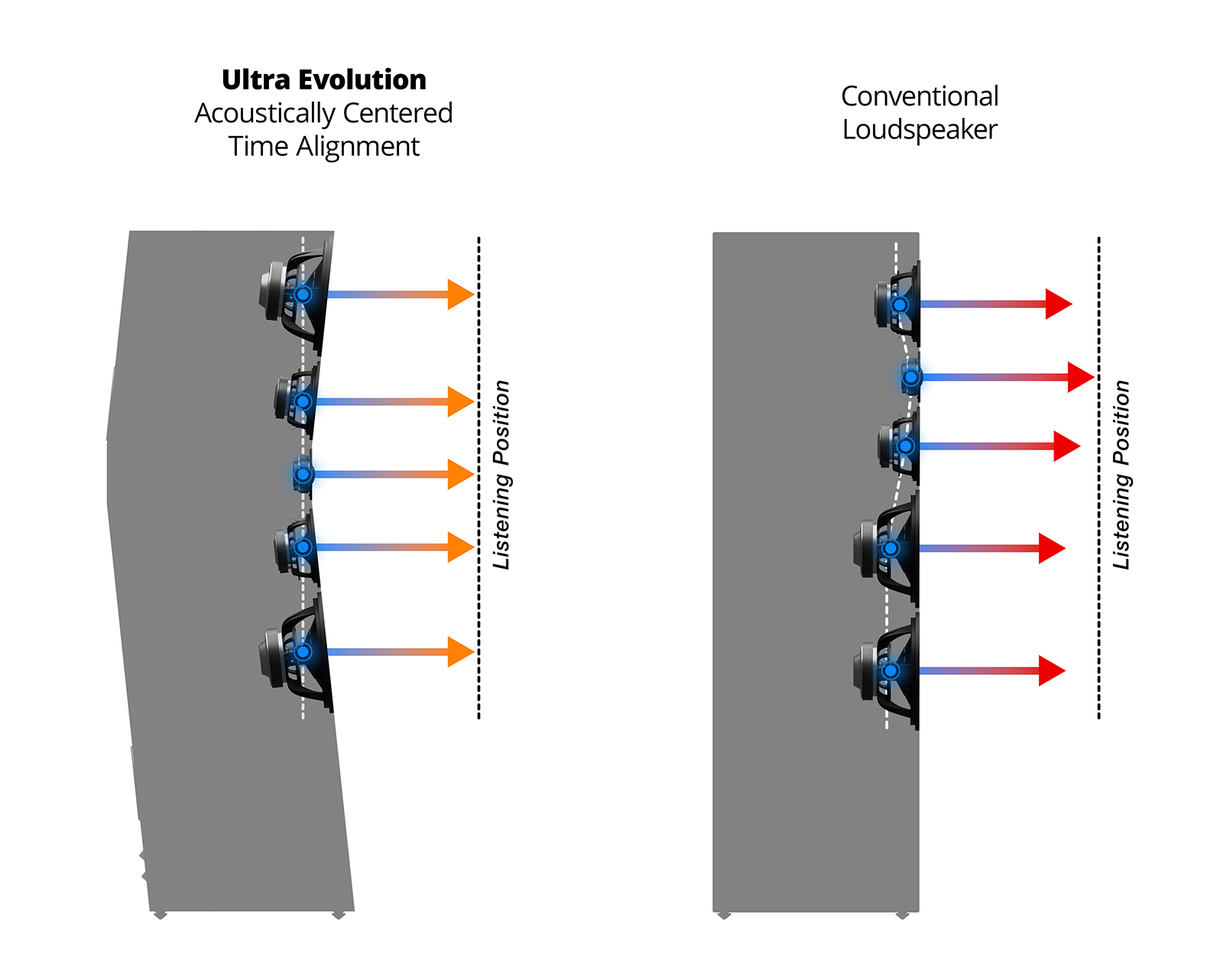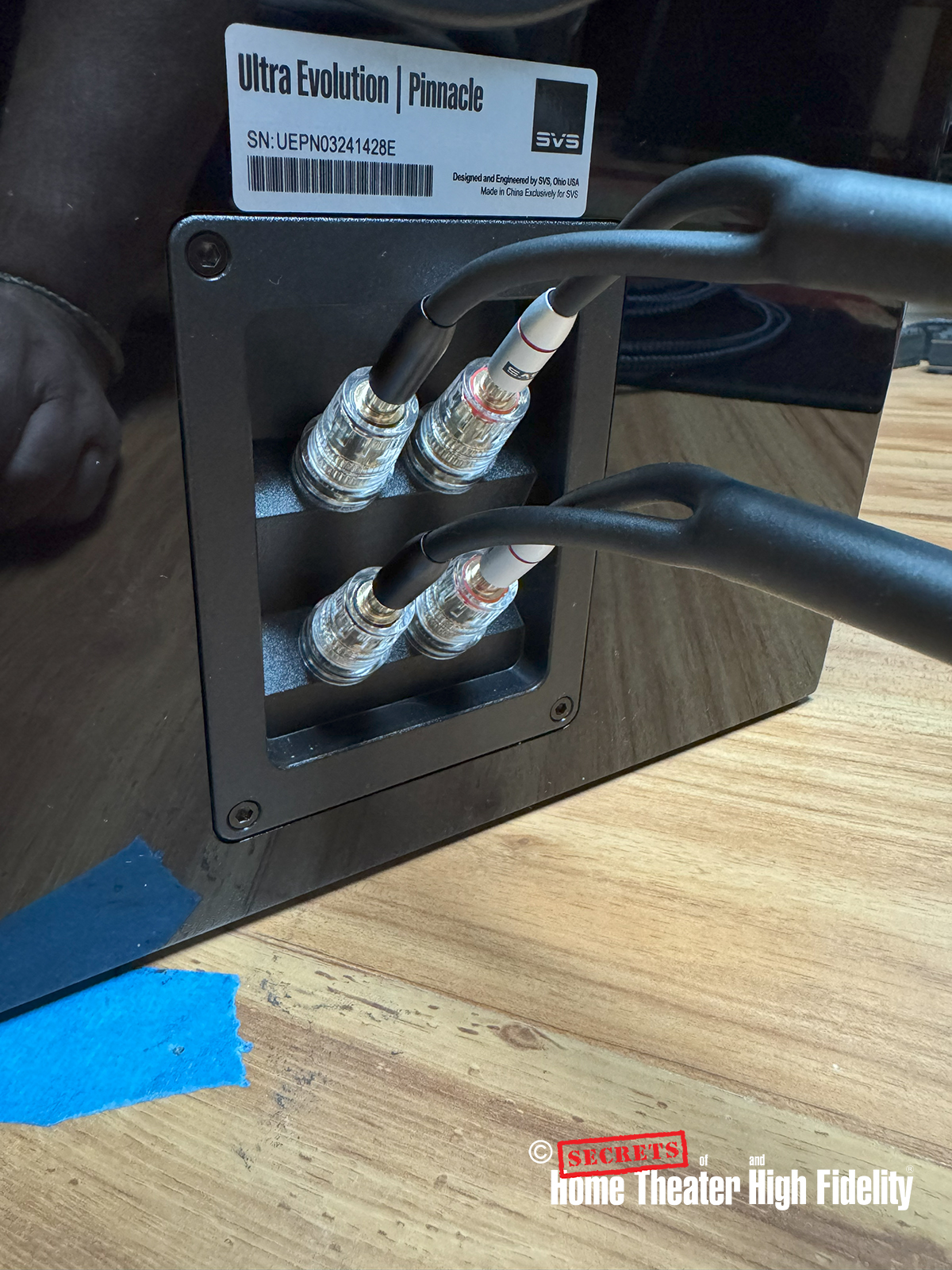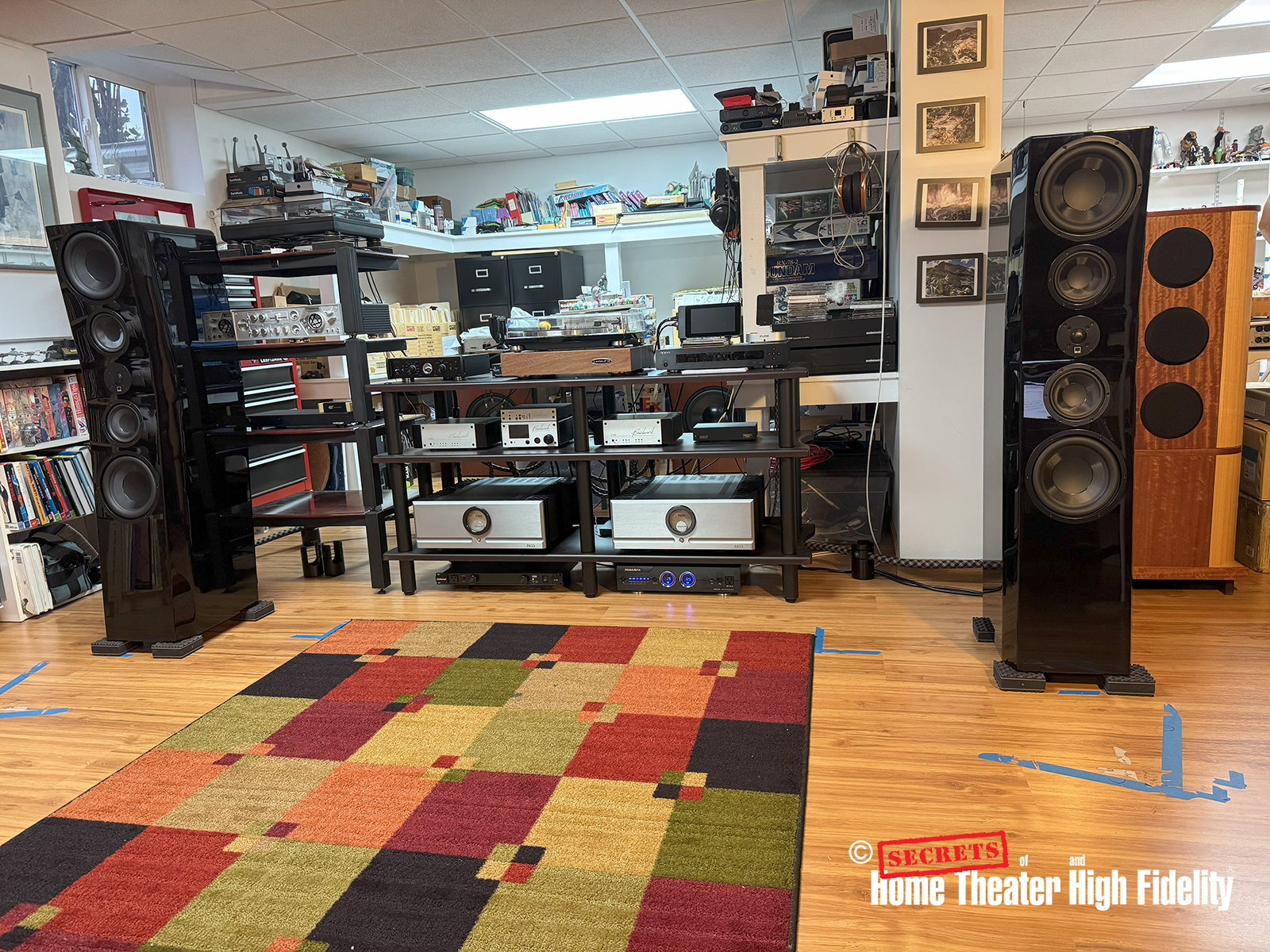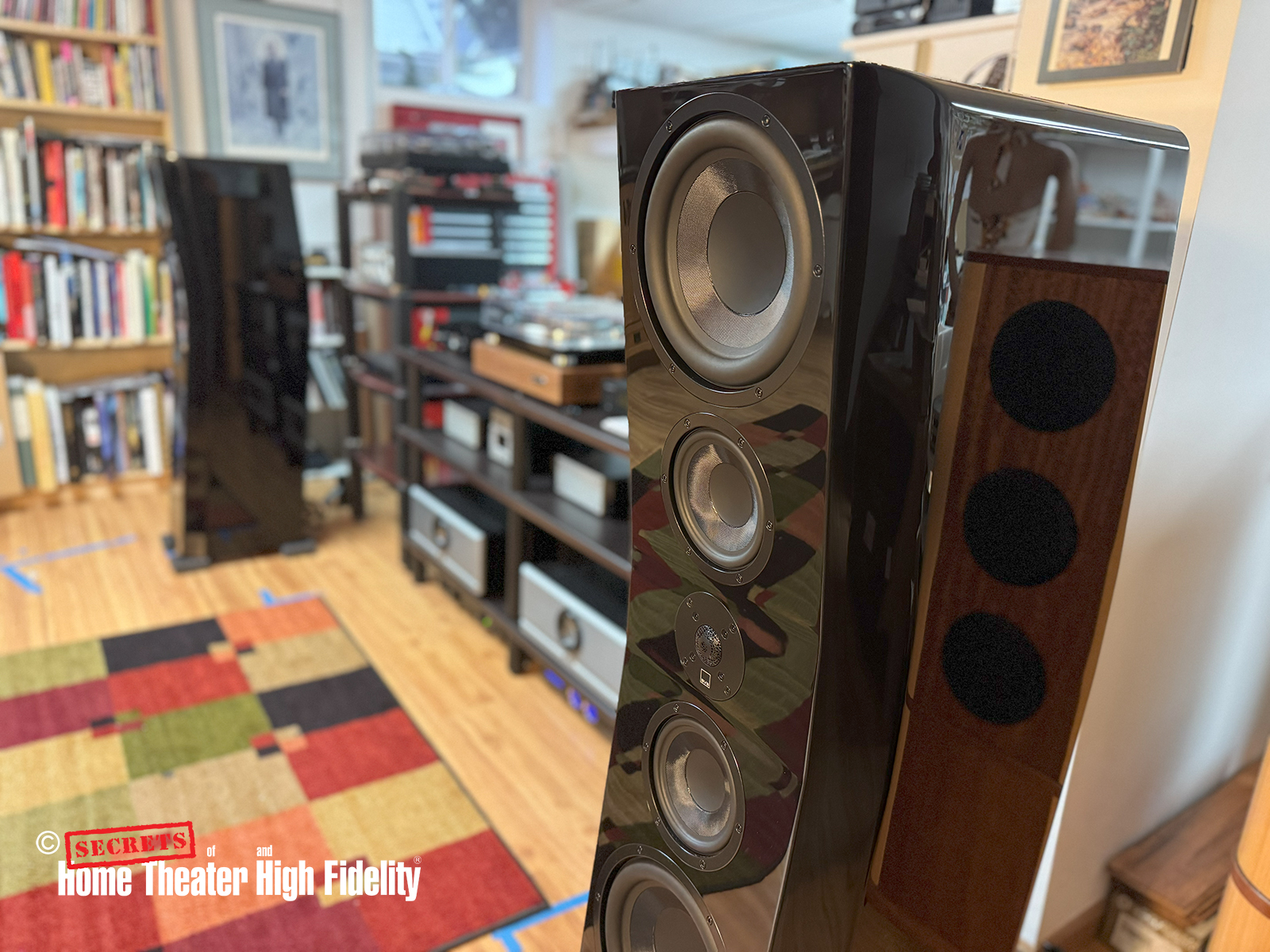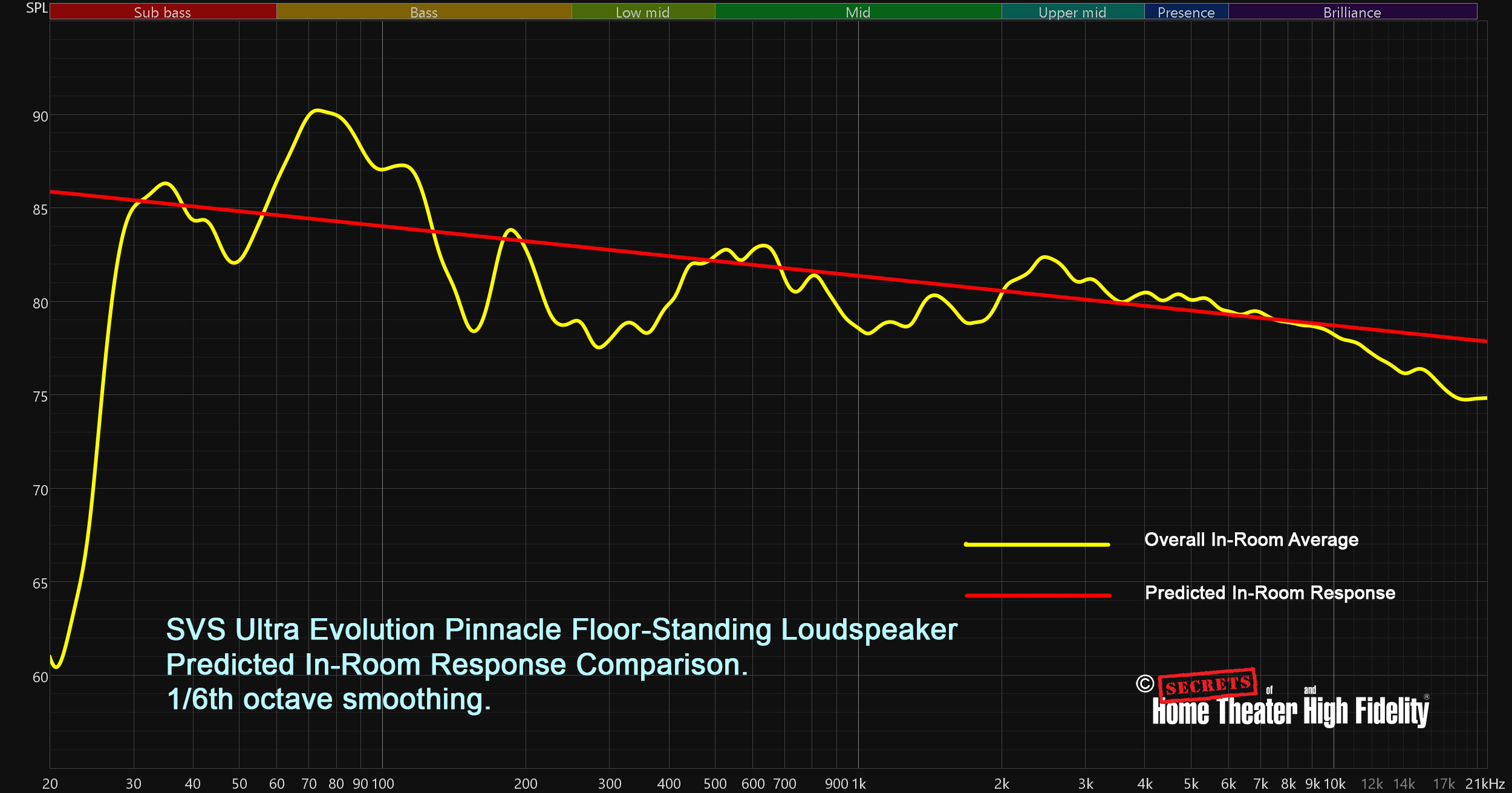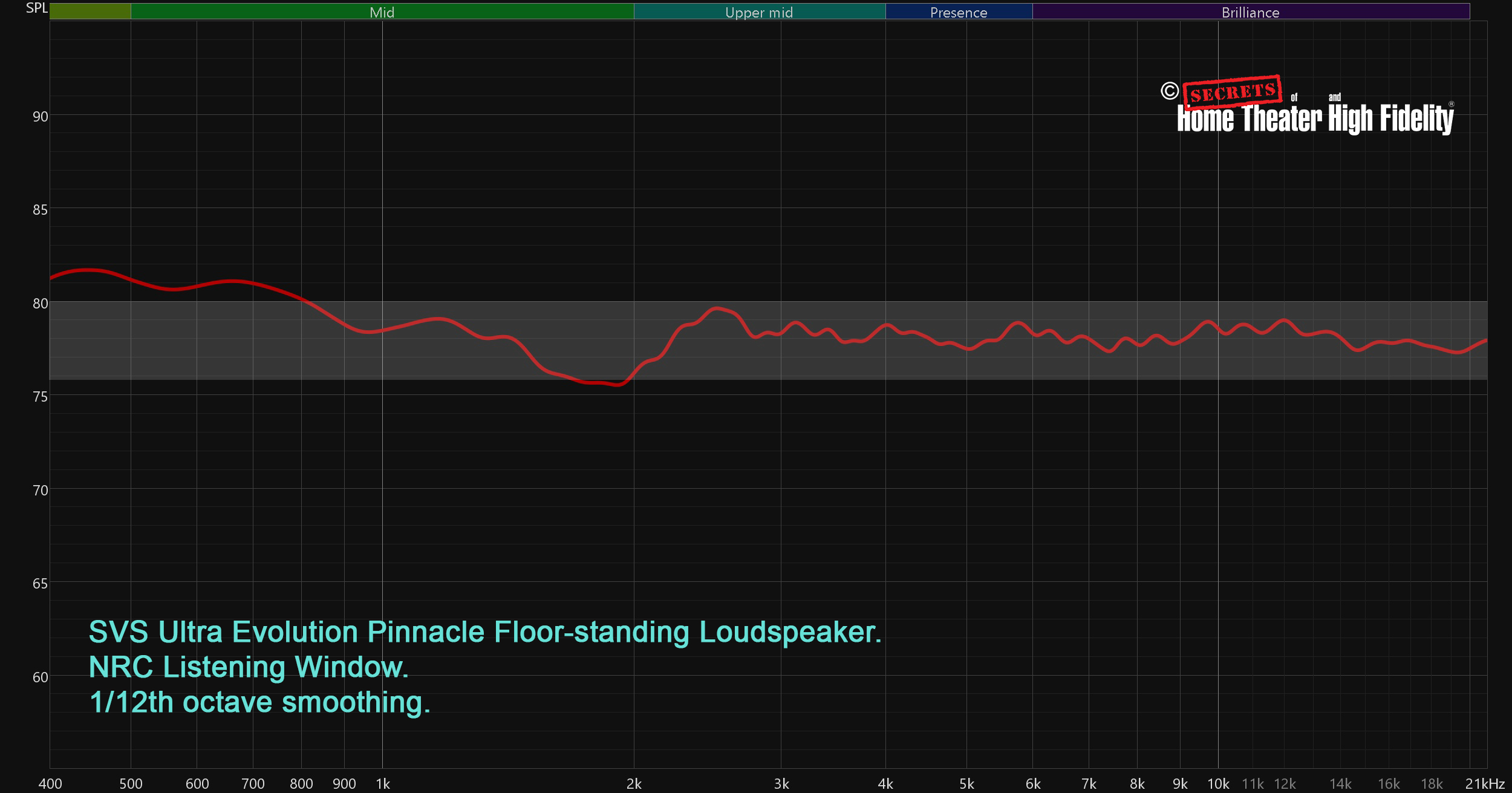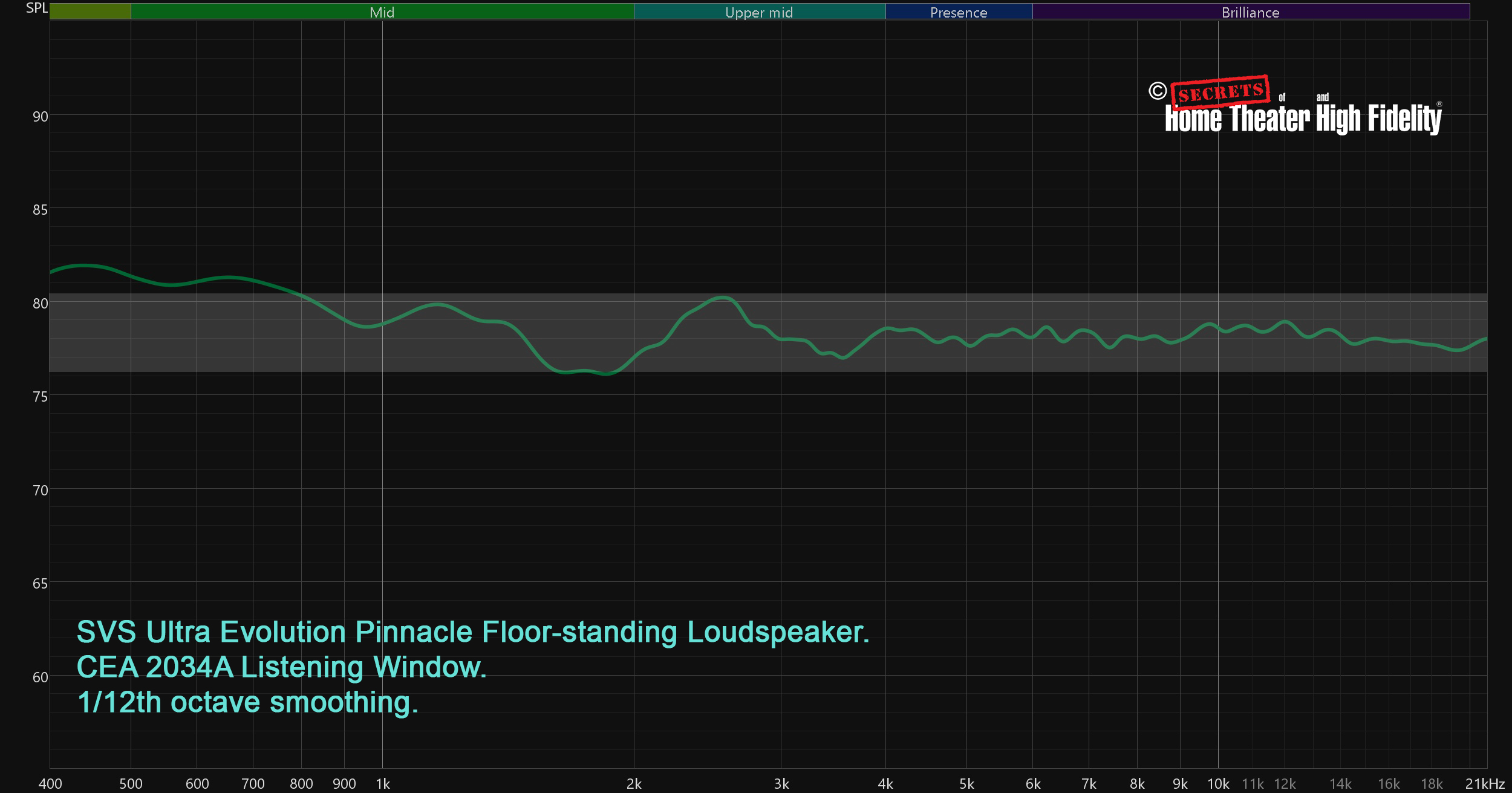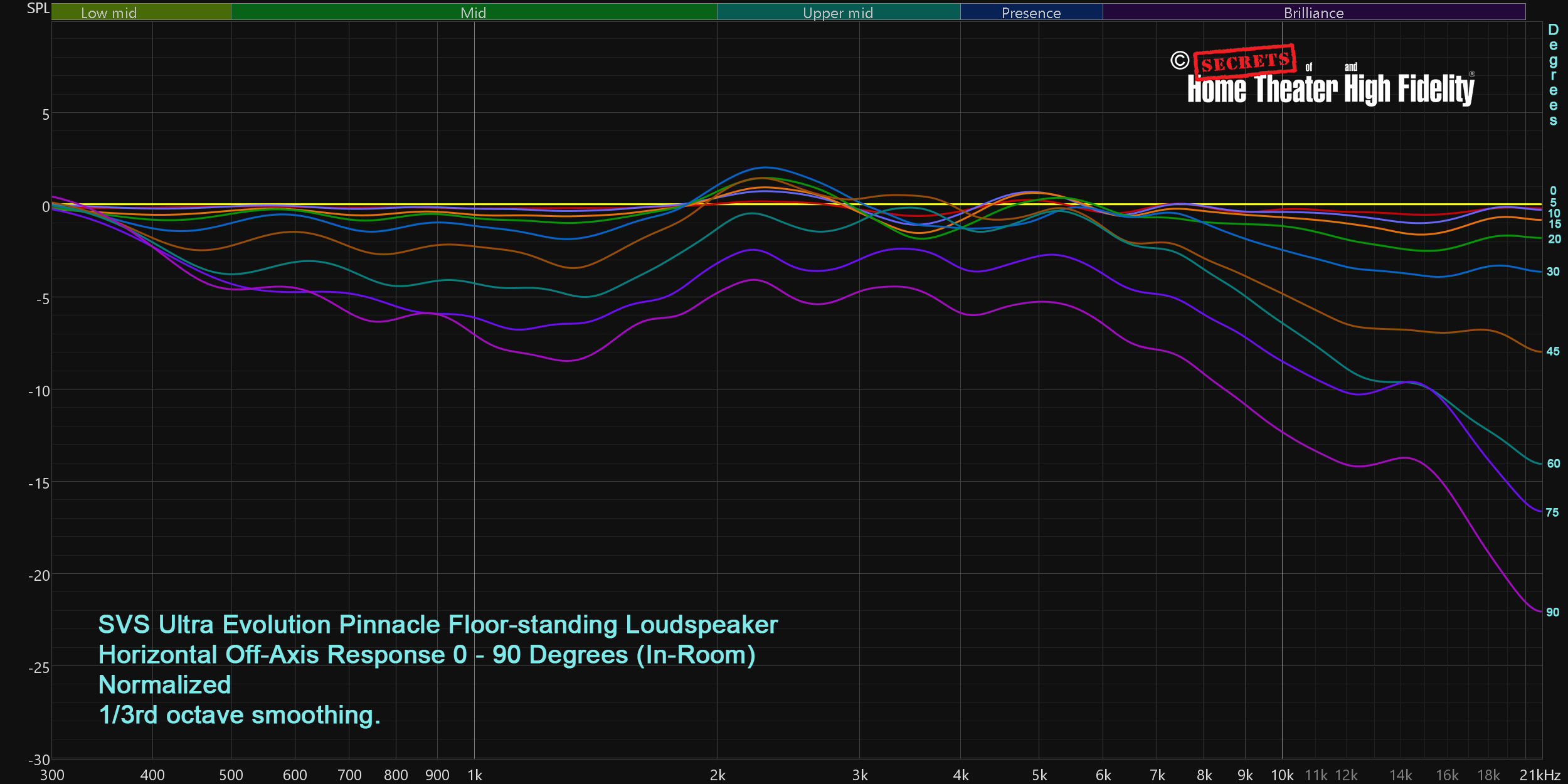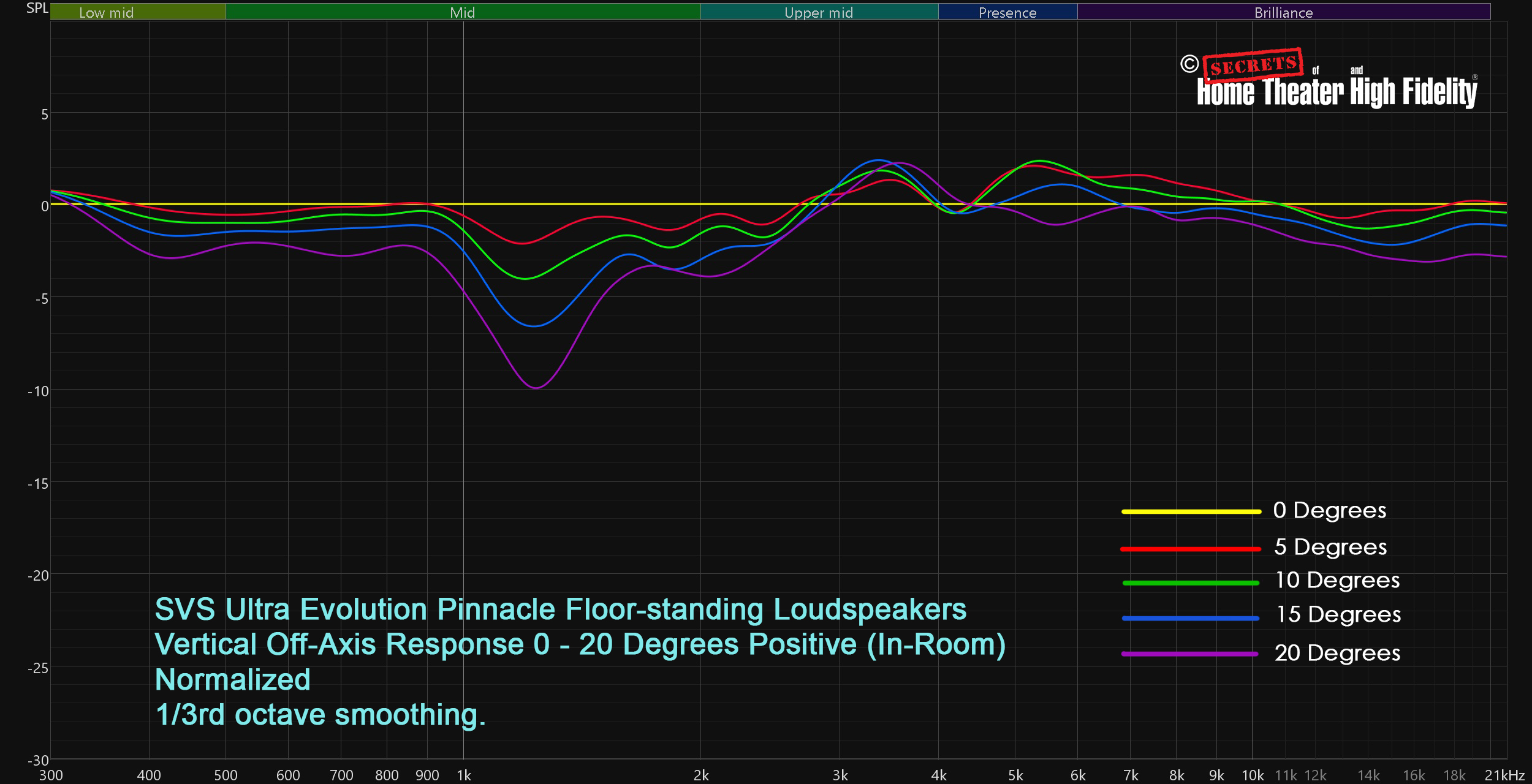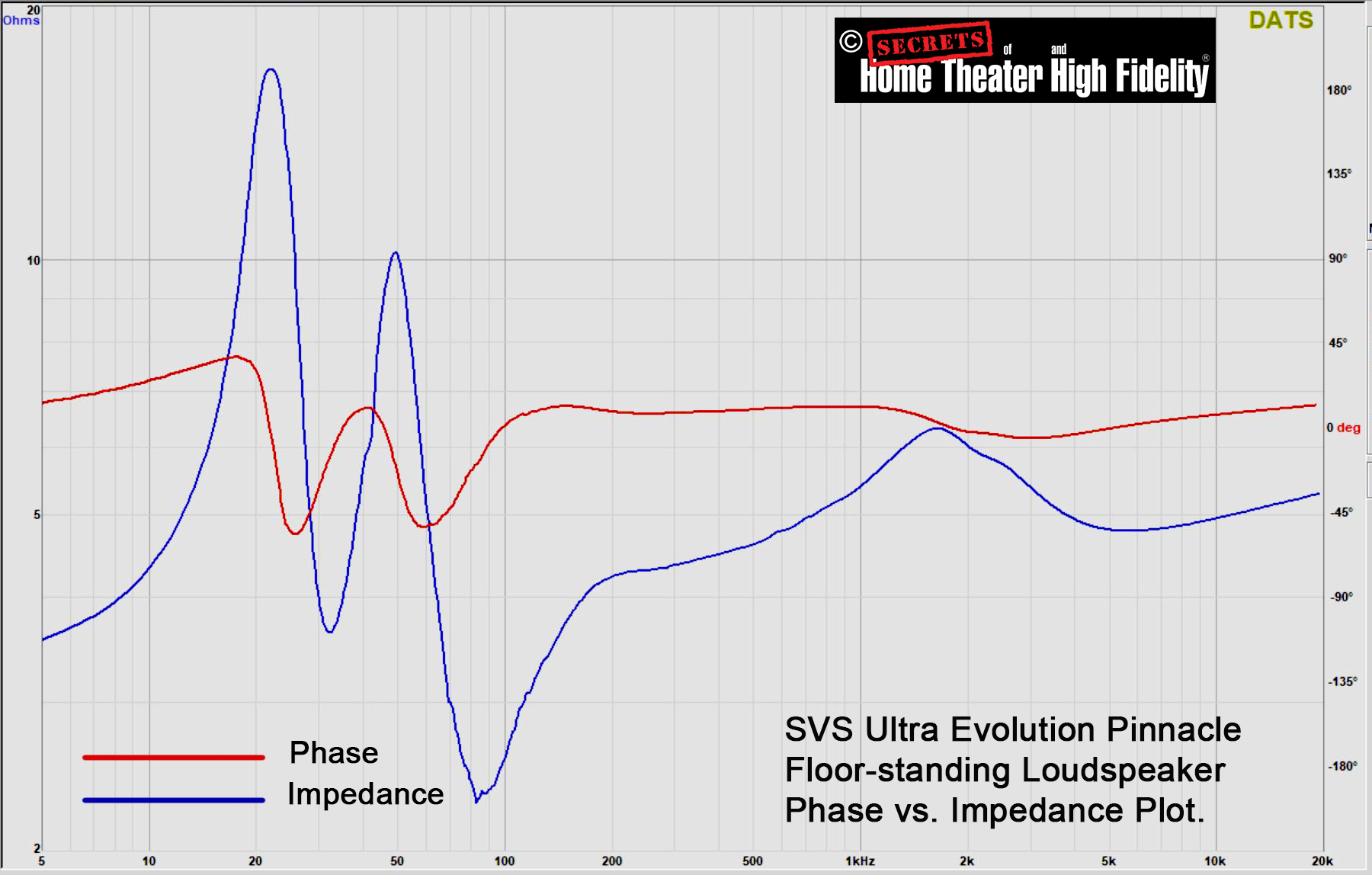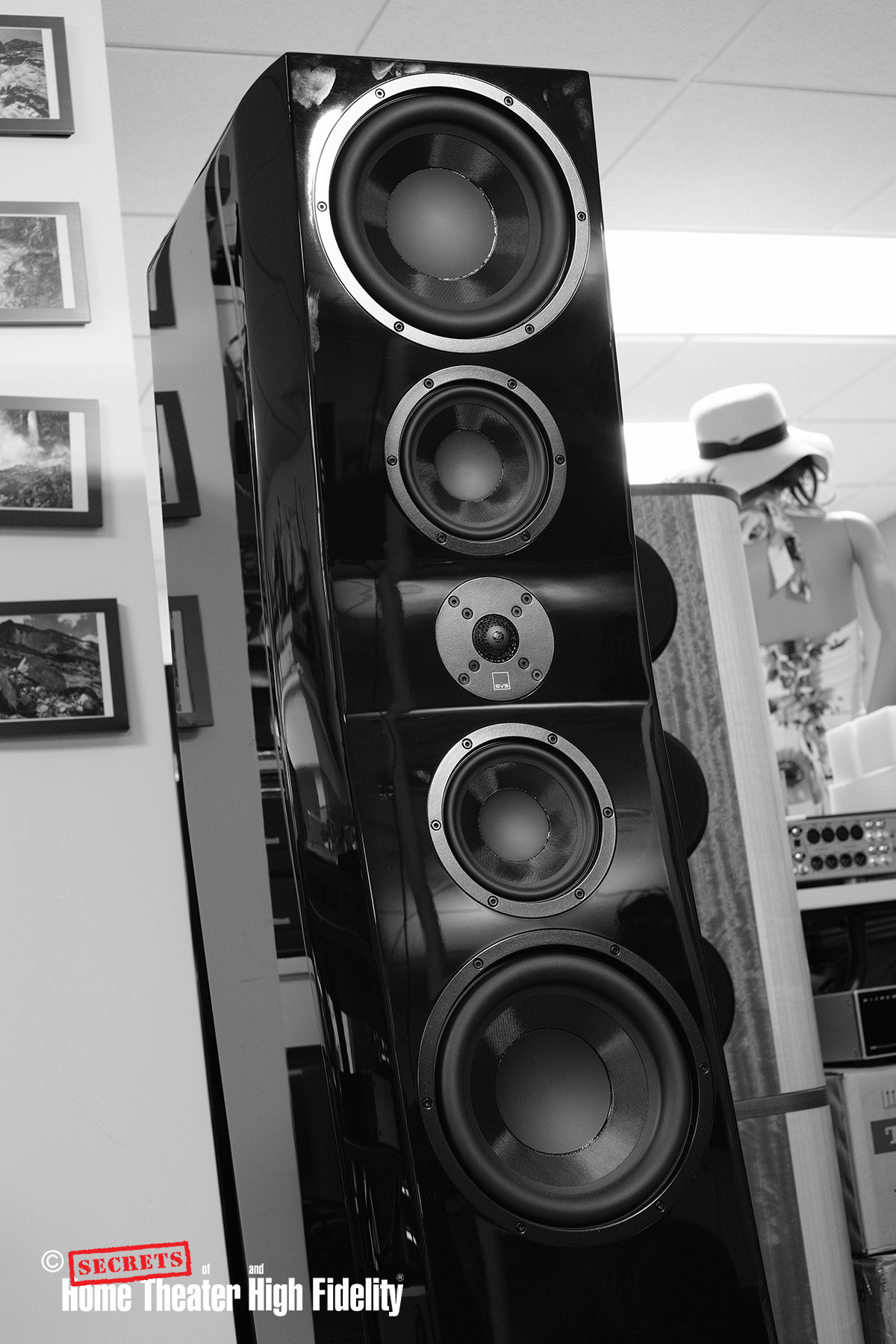When SVS decided to launch its latest range of loudspeakers, they decided to approach things a little differently from what had come before. Things like a completely unique (and distinctive-looking) cabinet, with a canted upper and lower front baffle that allows for physically time-aligning the drivers. A lower acoustic center of the speaker, with a centrally mounted tweeter, to help achieve more of a point-source projection of the sound. A pair of electrically active rear-facing bass drivers (not passive radiators) that help produce a more uniform bass response in-room. These, combined with the physical volume of the Ultra Evolution Pinnacle, aim to result in a speaker that will produce exceptional full-range performance with plenty of bass extension even in larger spaces.
SVS Ultra Evolution Pinnacle Loudspeaker
- Produces a solid and detailed musical image.
- Decent but not overly wide soundstage.
- Bass output was powerful and prodigious.
- Midrange sounded slightly recessed if you don’t sit right at the tweeter height.
- Outstanding build quality with a beautiful piano black finish.
- Prefers a larger room, or at least in my case, a room with higher ceilings. Bass could cause issues in a room with less than 8-foot ceilings.
SVS’s Ultra Evolution line consists of seven individual models, three towers, two bookshelves, one center channel, and a surround/elevation speaker. Plenty of options for a customer to create a compelling variety of installations for various applications. As the flagship model of the line, the Ultra Evolution Pinnacle is designed and presented as the ultimate statement of what the line embodies.
In my discussions with Gary Yacoubian (SVS CEO) and Nick Brown (VP of Marketing), they both made the point of how the company doesn’t introduce products willy-nilly, or for the sake of being the latest thing. There have to be substantive and worthwhile improvements over the previous generation for a new SVS product to be introduced. And the new Ultra Evolution Pinnacle is definitely a very different beast. A relative sea-change from any of SVS’s previous loudspeaker efforts, and something the company intends to stand against some of the best high-end towers in the market. So, how do SVS’s big towers stack up? Let’s find out!
Design:
3-Way Bass Reflex Floor-standing Loudspeakers with rear ports.
High Frequency Driver:
Single 1-inch Diamond-coated Aluminum Dome Tweeter.
Midrange Drivers:
Dual 5.25-inch Glass Fiber Composite Drivers with Cast Aluminum Alloy Baskets.
Bass Drivers:
Four 8-inch Glass Fiber Composite Drivers with Cast Aluminum Alloy Baskets. (Two front-mounted, two rear-mounted.)
Frequency Response (Manufacturer):
24 Hz – 40 kHz (+/-3 dB)
Nominal Impedance:
6 Ohms
Sensitivity:
88 dB (2.83 dB @ 1-meter full space 300 Hz to 3 kHz)
Crossover Points:
140 Hz, 1.8 kHz
Dimensions:
49.61” (H) x 11.81” (W) x 18.14” (D) / 1260mm (H) x 300mm (W) x 460.7mm (D)
Net Weight:
96.7 pounds / 43.9 kgs
MSRP:
$2,499.99 each
Website:
Company:
SECRETS Tags:
SVS, ultra evolution, pinnacle, loudspeakers, HiFi, audiophile
Secrets Sponsor
The Ultra Evolution Pinnacle is certainly something else, compared to what we’ve seen previously from SVS. At almost 50 inches tall and 97 pounds each, it’s probably the biggest and heaviest loudspeaker they have ever produced. From top to bottom, the drivers are arranged in a WMTMW (woofer, mid, tweeter, mid, woofer) order.
The woofers are 8-inch units that use composite glass fiber cones and cast aluminum baskets with a 1-inch-thick, 4.25-inch diameter magnet. They are built for high excursion, and along with there being two bass drivers on the front baffle, there are two horizontally-opposed, rear-firing bass drivers as well. While not physically connected on the inside, this arrangement should, according to SVS, theoretically cancel out any motion transferred to the cabinet from the bass drivers doing their thing, especially when being heavily taxed.
The two 5.25-inch midrange drivers also feature composite glass fiber cones and cast aluminum baskets. Their magnets measure 9/16-inches thick and are 3 1⁄8-inches in diameter. No doubt, the composite glass fiber material’s inherent lightness and rigidity were found to be desirable qualities suited for use in both the woofer and midrange drivers.
For the high frequencies, SVS is using a 1-inch aluminum domed tweeter that features a vapor-deposited diamond coating. SVS claims that the additional coating increases the tweeter’s rigidity and extends the upper and lower frequency extension beyond what aluminum alone is capable of. In real terms, any tweeter resonant frequencies or breakup modes are likely pushed outside the audible spectrum, and a lower reach allows for more flexibility to achieve a better hand-off to the midrange drivers.
In the absence of a waveguide, the tweeter dome itself is covered by what SVS calls an “Organic cell lattice tweeter diffuser.” This looks similar in concept to other tweeter “lenses” or phase diffusers like what Paradigm does with their PPA™ tweeter lenses on various speakers. This is essentially used to reduce the interaction of out-of-phase frequencies and smooth the tweeter’s response. SVS claims that it also helps widen the listening sweet spot.
The Pinnacle’s enclosure uses 3⁄4-inch MDF for the sidewalls and internal bracing and 1-inch MDF for the front and rear baffles. The midrange and tweeter drivers are also in their own separate enclosure, isolating them from internal acoustic interference from the forces of the four bass drivers. When viewed from a profile, the cabinet’s overall shape is canted or concave, for lack of a better term. This allows the drivers to be physically time-aligned so that the bass, midrange, and tweeter driver outputs arrive at the listener’s ears at roughly the same time. Technical Editor, David Rich, will examine this in detail later in the Bench Test section.
According to SVS, the crossover slopes used on the Ultra Evolution Pinnacle are 2nd order (12 dB per octave) on the tweeter low pass, midrange driver high and low passes, and a 3rd order slope (18 dB per octave) on the woofer driver low pass.
The speakers are equipped with two sets of 5-way binding posts with removable straps, suitable for bi-wiring or bi-amping. The terminals can easily accommodate bare wire, banana plugs, or spade lug terminations. For feet, SVS conveniently includes both screw-in carpet spikes and rubber footers for use on a variety of flooring.
The SVS Ultra Evolution Pinnacle is currently available in either piano gloss black, piano gloss white, or black oak veneer. Personal opinion, a custom walnut or rosewood finish would look gorgeous on these speakers. Food for thought, SVS!
The Ultra Evolution Pinnacles were positioned in my large studio listening space roughly 9 feet apart, with the listening position approximately 10 feet away from the center point between the speakers. After some experimentation, I settled on the speakers themselves pretty much pointing straight into the room with almost no toe-in. It gave me the best compromise of a wide soundstage while maintaining detailed imaging. I also found that I needed to switch to a lower listening chair in order to get my ears at the same level as the tweeter. The speaker’s imaging didn’t sound quite right when I was in my usual chair, which put my ears decently above the tweeter height.
The associated equipment used for stereo evaluation consisted of:
– Two Pass Labs XA-60.8 Monoblock Power Amplifiers.
– Two Benchmark AHB2 Power Amplifiers.
– Benchmark DAC3 B Digital to Analog Converter.
– Benchmark HPA4 Preamplifier.
– Anthem STR Preamplifier.
– Anthem STR Power Amplifier.
– AXIOM ADA-1000 5-Channel Power Amplifier.
– OPPO BDP-105D Universal Disc Player.
– GeerFab D.BOB Digital Breakout Box.
– DIY Raspberry Pi-based Endpoint.
– Technics SL1200 Mk6 Turntable modified by KAB Electroacoustics.
– Audio-Technica ART20 MC Phono Cartridge.
– TEAC PE-505 Fully Balanced Phono Preamp.
– Viablue Interconnects.
– SVS SoundPath Ultra Speaker Cable.
– EVP Vibration Protectors from AV RoomService.
One other point that I should mention up front is that my basement studio has an acoustic tile drop ceiling, which limits my room height to 7 feet. In the past, I’ve noticed that some taller speakers or speakers with bass drivers at the top of the cabinets can cause bass at about 70 Hz to be excited in this room, along with a certain amount of cancellation between 200 Hz – 400 Hz. This can, to varying degrees, cause two issues when listening to music. First is a bloated sense of bass with reproducing stand-up bass, kick drum, some electronic bass, etc. The other issue is a sense of leanness in the lower midrange area, which, if the deviations are significant, can make piano lack a measure of body to its sound, and it can also suck the drive out of most rock music, too, making it sound overly flat and two-dimensional. Perceptually, (at least for me), I am used to a certain amount of “lean-ness” in the upper bass to lower midrange area. And when that is combined with a moderately boosted bass level, the effect can sound (again, at least to me) somewhat lively and pleasing, within reason. It’s this sort of stuff that can make room correction in the bass region a handy tool for 2-channel listening. So, this was at the top of my mind when setting up these not-insubstantial loudspeakers.
Right off the bat, the SVS Ultra Evolution Pinnacle had no problem generating significant quantities of bass. Even in my room, with the speakers positioned well away from the back wall, they definitely sounded like they doled out some serious additional punch with kick drums and stand-up bass. Thankfully, it didn’t sound like the bass was over the top, but it made me wonder if placing them in the more traditional two–to–three feet from a back wall location wouldn’t make the bass sound really oversaturated. I then tried removing about a half-dozen ceiling tiles from just above and around where the speakers were, effectively adding another foot of ceiling height along with exposing some ceiling insulation. This resulted in the bass punch dropping a noticeable amount.
Just by a few dB if I had to guess. It was still there to be sure, but it was a little smoother and a little tighter sounding than before. So, let’s park that observation for a minute.
In terms of any upper midrange cancellation that the speakers may have exhibited, it was mildly noticeable in my normal listening with my standard ceiling height, listening to the music cues I usually look for. With the ceiling tiles removed, I noticed a little more fullness to the sound in that region, not drastic, but enough to notice and appreciate. Of the two, the bass attenuation was definitely the more noticeable change with the ceiling height shift.
What does that all mean? Well, the SVS Ultra Evolution Pinnacle can move a lot of air, and even if you have a big space in your room, if you are ceiling height limited, then perhaps the next step down in the Ultra Evolution line might be more suited to your space. If you are using these in a home theater, and you are employing some measure of room correction, then that mitigates things a bit. Just something to keep in mind if using these speakers strictly for two-channel listening without electronic correction.
Another thing to keep in mind is that the tweeter position is lower than what we traditionally see on a comparable tower speaker. And, for me, these speakers sounded at their best when I lowered my typical seating position and had my ears more in line with the tweeter height. When I was able to do that, the sonic image fully locked in place, and everything sounded much more dimensional. Raising the speaker’s height by about an inch using EVP Vibration Protectors and switching to a low-back club chair to sit in, lined my ears up just right.
Now, with that all sorted out, how did these bad boys actually sound? Pretty darned good, all things considered. I combined the big SVS Speakers with a variety of amps, including my dual mono Benchmark AHB2 amps, my big Anthem STR power amp, bi-amplified using four channels of my AXIOM ADA-1000 5-channel amp, and a pair of XA60.8 Class A Monoblock power amps from Pass Labs. The speakers seemed to revel in the gobs of available power on tap from each combination. I’d be hard-pressed to pick an amplifier pairing from this lot that I liked best or that I thought subjectively sounded “superior.” If you put the preverbal “gun-to-my-head,” though, I would say the Pass Labs amps had a certain level of smoothness and just the right appealing level of warmth to their sound that mated especially well with these speakers. All the other amps were clean, transparent, and also sounded excellent in use, no question about it. However, using the Benchmark preamp, Pass Labs amps, and SVS speaker chain just had that little extra special something that made it “all systems GO!” Some out there might scoff at the notion of the SVS speakers being worthy of the Pass Labs amps, but I beg to differ.

Ahmad Jamal, “Ballades”
Listening to “So Rare” from Ahmad Jamal’s album Ballades showed the speaker’s impressive ability to reproduce the full body of a well-recorded piano effectively. Particularly in the transition from the midrange to the lower register notes, any concern I may have had about some lean-ness to the sound in that region didn’t materialize. While the overall size of the soundstage may not have been the absolute widest that I have experienced before, it was big enough to translate the scale of the initial ring, then the expansion, and decay of all the notes effectively. And those low notes really had a nice sense of weight and depth to them as well. Bassist James Carmack’s playing also sounded excellent, with the deep, authoritative plucks of his double bass having plenty of detail, musicality, and an almost visceral impact to each one. The SVS Ultra Evolution Pinnacle did a great job of keeping simultaneous low bass and low piano notes very clear and distinct sounding when both were weaving in and around each other.

ZZ Top, “RAW: That Little Ol’ Band From Texas Original Soundtrack”
Shifting gears to something a little less refined, ZZ Top’s “Tube Snake Boogie” from their album RAW gave the Ultra Evolution Pinnacles some loud, distortion-filled Blues to sink its teeth into. Right from the get-go, the speaker’s bass capabilities stood out with the sheer intensity and depth of Frank Beard hitting those skins and pounding on the kick drum, along with (the late) Dusty Hill’s rumbling bass line opening up the song. The hits were tight and solid, and I could feel them in my gut, right before Billy Gibbons came in with that meaty-sounding distorted guitar snarling across the speakers. The SVS speakers played this track unabashedly big and loud as I was cranking up the volume to hear if the sound would compress at all. Nope, even as Billy Gibbons’ haggard, swampy vocals came in, the Ultra Evolution Pinnacles kept all this nasty, distortion-riddled fun sounding composed and clear even at higher than sane volumes.
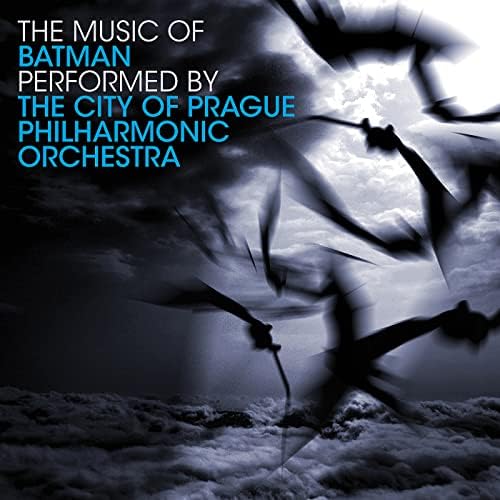
The City of Prague Philharmonic Orchestra, “The Music of Batman”
The Ultra Evolution Pinnacle speakers could pass for something that one might discover in a trip to the Batcave, so what better music to follow up with than the track “Aggressive Expansion” from The Music of Batman, performed by the City of Prague Philharmonic Orchestra. A very brooding composition with a powerful opening and closing, along with a section of deep rumbling atmospheric bass in the middle. The powerful bass drum hits that punctuate the beginning and end of this track sounded properly tremendous. Solid, tight gut punches that pretty much confirmed that these speakers really don’t need subs in a standard stereo listening arrangement (no harm in wanting them though, but that’s another story). Yet with all their bass prowess, the speakers also handled the delicacy of massed strings very well with a warm and detailed character that never got anywhere close to sounding abrasive. If I had any complaints with this track, it’s that I’m used to hearing some measure of depth in it when listening to my reference speakers (the Revel F228Be), and I was missing some of that sense of depth here with the SVS. The presentation was just a little flat overall.

Melody Gardot, “My One and Only Thrill”
To hear how the Ultra Evolution Pinnacle handled female vocals, I cued up selected tracks from Melody Gardot’s My One and Only Thrill album. “If The Stars Were Mine” is a particularly layered track with a lovely acoustic guitar and some bongos underpinning several other delicate instrumental flourishes. The speakers reproduce everything with an excellent level of detail and a relatively broad positioning of each element in the soundstage. The aforementioned acoustic guitar has an appealing warm tone with plenty of string detail, and when the player occasionally slaps the body of the guitar, the Ultra Evolution Pinnacle gives each slap a nice weight to the sound. There is some kind of shaker that is used for percussion (not quite maracas) that has a nice crisp detail to its sound, and the bongos sounded very detailed, with the impression of the player’s hands hitting the skins being successfully relayed by the speakers. And then there is Melody Gardot’s voice. Perfectly centered and just a little forward in space from everything else, it sounds smooth, warm, and clear without any sort of sibilance. If I’m pressed, I think her voice lacked just a bit of sparkle in the higher registers, but I think this speaker is a slightly warmer-sounding reproducer in general, and that aspect of its character isn’t really objectionable in my mind. Overall, an enjoyable listen.
Secrets Sponsor
Bench tests were performed with a Cross-Spectrum Labs calibrated UMIK-2 microphone connected to my computer workstation using Room EQ Wizard acoustic measurement software.
All near-field measurements were made with the microphone tip centered at the tweeter driver (0-degrees) at a 1-meter distance from the speaker, with the test speaker positioned as far away from any walls as possible. The on-axis (0-degree) response in our nearfield measurements is made flat in the normalization process. As such, the resulting response variations are only due to the changes in either the horizontal or vertical axis.
The In-room average response measurements are derived from an 18-point spatial average taken from around the listening position (11 ft away), with the microphone capsule placed at ear level.
Phase and Impedance measurements are done using a Dayton Audio DATS V3 Audio Test System.
Caveats: Unlike measurements taken outdoors or in an anechoic chamber that measures a speaker in isolation, in-room measurements give a sense of how a speaker behaves in the actual environment in which it’s used. Both types of measurements are valuable (make no mistake, a properly designed speaker in an anechoic environment will hold up much better in an average listening space), I just find in-room measurements interesting as they help shed light on what I am hearing and why. Note that no in-room measurement will ever match an anechoic measurement, and a measurement taken in my room won’t necessarily match a similarly done measurement taken in your room. But, after measuring dozens of speakers here, I’ve acquired a good understanding of how this space interacts with the speakers under test, and some general performance observations can always be drawn.
This in-room measurement of the SVS Ultra Evolution Pinnacle tower speakers is an 18-point spatial average. A 9-point measurement was made for the right speaker and then repeated for the left speaker. Averaging both speakers is an approach others have been using and publishing. Using data from both speakers reduces the modal response of the room by averaging the differences in the response of the two speakers from room asymmetries. The technique cannot eliminate them, however, and so the response below 300Hz remains room-dominated.
David Rich notes:
The extra bass energy between 60 Hz and 130 Hz correlates with both ground-plane and anechoic measurements that other outlets have published. It has most likely been designed into the speaker intentionally.
The energy loss from 1 kHz – 2 kHz and the peaking at 2 kHz – 3 kHz will be seen in the near field listening windows below. It is more apparent in the CEA 2024 listening window.
The red line on this graph is a linear fit to the in-room response. Comparing this slope to that of previous speakers reviewed in Carlo’s room reveals whether the speaker exhibits a characteristic of a studio monitor (less slope) or is more forgiving, with a faster slope. No correct answer exists, and what characteristic is more desirable is subject to personal preference. Given the issues with Carlo’s room with this very large speaker, I limited the attempt to fit the line of speaker response with a lower limit of 400 Hz. The slope of the line is -0.8dB per octave. As a comparison, the Perlisten S7t and YG Acoustics Vantage 3 Live (review coming soon) had a slope of -0.7dB per octave in Carlo’s room. Both these speakers exhibited a minimum amount of deviation from the linear target. The Vantage 3 Live uses DSP. The TAD CE-1TX had a slope of -0.9dB. The Sonus faber Olympica Nova 5 had a lumpy slope of -0.6dB per octave.
The slope of the line is the dominant subjective reaction to a speaker if the speaker closely corresponds to the line. The peaks and dips around the line can be heard as a defect if the speaker is compared to a more linear speaker. Hearing these characteristics is best done under blind conditions.
The width of the horizontal radiation pattern, which we will look at below, also produces a sonic signature under blind conditions.
This is a plot of the NRC listening window for the SVS Ultra Evolution Pinnacle, scaled from 400 Hz on up, which is averaged from the following measurements: 0-degree on- axis, +/-15-degrees vertical, and +/-15-degrees horizontal. This is the portion of the frequency range that is dominated by the speaker (response below 300 Hz tends to be dominated by the room and can vary greatly).
David Rich notes:
The response above is dominated by the dip in the 1 kHz – 2 kHz range, which we saw in the in-room response.
A small peak is seen at 2.5 kHz. Flatter than the in-room response.
One would expect the in-room measurements Carlo produced would look different from when the measurement is made in the large NRC anechoic chamber in Canada, but above 300Hz, the curves are similar. The listening window is the third curve down.
This is a plot of the CEA-2034A listening window for the SVS Ultra Evolution Pinnacle, scaled from 400 Hz on up, which is averaged from the following measurements: 0-degree on-axis, +/-10-degrees vertical, +/-10-degrees, and +/- 20-degrees horizontal. This is the portion of the frequency range that is dominated by the speaker (response below 300 Hz tends to be dominated by the room and can vary greatly).
David Rich notes:
Typically, the CEA-2034A and NRC listening windows look similar, but that is not the case for the SVS. The peak at 2.5kHz has grown in width and amplitude. The CEA-2034 weighs the horizontal response more with four measurements in that plane. This suggests that an answer to the difference will be found in the horizontal dispersion shown next.
On the positive side, the response above 4kHz is slightly flatter. The CEA-2034 uses a narrower angle of +/-10 degrees in the vertical axis compared to the +/- 15 degrees for the NRC listening window.
The takeaway is that small changes in measurement technique produce larger changes than typical.
Above are the normalized horizontal radiation curves of the SVS Ultra Evolution Pinnacle from 0 to 90 degrees, scaled from 300 Hz on up, measured in-room in the near field. In a normalized curve, the on-axis curve is changed to be a flat line, so only the differences in response caused by the changes in angles are seen.
David Rich notes:
The response to 1 kHz shows the response of the midrange with increasing angle.
As we approach the 1.8 kHz crossover to the tweeter, the radiation pattern narrows. The tweeter has no waveguide, so the response moves close to 0 dB and, in some cases, exceeds 0 dB.
As the tweeter becomes directional, the horizontal response widens again.
The crunch of the curves at 2.5 kHz corresponds to the peak we see in the in-room and listening window curves. As mentioned above, the CEA-2034A is more strongly weighted to the horizontal response, which explains why it shows a higher and wider peak.
Above 4 kHz, both listening windows are very flat. The oscillatory patterns in the curves above 4 kHz may be a diffraction effect from the offset baffles of the midrange and tweeter, although we cannot confirm this.
How far off-axis you can get from a speaker with minimal change in tonality is directly related to the horizontal radiation pattern. Some listeners in controlled conditions report a wide radiation pattern to produce a more spacious sound. Carlo mentions a good level of spaciousness in his subjective comments.
The horizontal radiation curve does not correspond to a well-controlled, wide radiation pattern. A significant change in the response with increasing angle can be seen from 500 Hz to 2 kHz. The tweeter rolls off quickly with larger angles above 8 kHz.
As we say in the changes between the CEA 2034 and NRC listening windows above, small changes in the angles correspond to the complexity of this curve and the vertical radiation curves to follow.
With the SVS, the horizontal off-axis response does not match the shape of the on-axis response in the crossover area. This would be noticeable subjectively in a blind test.
Moving to the normalized vertical radiation pattern for positive angles. We see the plots of 0 to +20 degrees, scaled from 300 Hz on up, measured in-room in the near field.
David Rich notes:
Speakers with midranges above and below the tweeter exhibit significant changes in response around the crossover. This is somewhat mitigated with a lower crossover frequency.
The oscillatory pattern above 3 kHz is hard to explain. A guess would be diffraction effects from the complex cabinet shape. The offsets may solve a problem that is not significant, as we will show below, for issues in the range of the tweeter.
Here we have the normalized vertical radiation pattern for negative angles. We see the plots for 0 to -20 degrees, scaled from 300 Hz on up, measured in-room in the near field.
David Rich notes:
The negative response is similar to the positive response. This is likely due to the symmetrical midrange deployment around the tweeter. Note that the horizontal and vertical response shows a dip in the 1kHz – 2kHz frequency range, which corresponds to the listening window measurements.
Here we have the Impedance sweep for the SVS Ultra Evolution Pinnacle. The results show that the speaker remains below 5 Ohms from 5 Hz to 13 Hz, from 30 Hz to 40 Hz, from 60 Hz to 800 Hz, and from 3.5 kHz to 10 kHz. There are peaks as high as 17 ohms at 22 Hz and 10 Ohms at 50 Hz, respectively. The speaker hits an impedance low of 2.4 Ohms at 85 Hz. The Ultra Evolution Pinnacle specifications rate its nominal impedance as 6 ohms; we think it would be more accurate to describe it as a 4-ohm nominal speaker.
Here we have the step response for the SVS Ultra Evolution Pinnacle loudspeaker.
David Rich notes:
This is the step response of the speaker calculated by REW from the impulse response.
As expected for a speaker using high-order crossover networks, the acoustic response out of the speaker shows significant delays over frequency. This can clearly be seen in the time domain.
The midrange is in the opposite polarity to the tweeter, which is correct for a 3rd order Butterworth crossover (anechoic acoustical response of the speaker). It has no sonic consequence, although Butterworth filters have a 90-degree phase shift between the drivers, which can affect the vertical radiation pattern.
The crossover delay swamps the effects of the minor physical driver offsets. Modern CAD tools can optimize the performance of the speaker with a flat baffle at the crossover by making small changes in the crossover components using an optimization procedure option in the CAD tools.
The only way to get an impulse response that approaches a Dirac function (named for physicist and mathematician Paul Dirac) is with DSP. In “technical-speak,” the inversion of the speaker’s impulse response is sent out of the time domain equalizer. When convolved with the speaker’s impulse response, we get the desired results. This is possible with the magic of DSP being able to operate in a non-causal fashion and processing the signal in negative time, resulting in a significant delay between the sound entering the time domain equalizer and the output of the speaker.
It should come as no surprise that the Dirac (the company) room correction system does what I describe above. It works. I have tested it with multiple speakers, and the impulse response approximates the ideal over a range of microphone placements. Full range time domain correction occurs with Dirac room correction, regardless of the upper limit correction in the frequency domain. I have set that as low as 100 Hz in the Dirac control panel and still got complete range phase correction.
Trinnov does the same process to align the speaker in the time domain. With REW and a sound card, you can see the inverted time domain response by connecting the room correction system alone to the sound card. Just compare that with the speaker’s actual impulse response measured acoustically with REW.
All these words are my way of saying that physical driver offsets are not going to solve the problem. We need a 21st-century solution that works amazingly well.
That Dirac and Trinnov can optimize the speaker in the time domain, as easily seen with REW, does not necessarily mean the sound is better. Double-blind tests have shown that the ear is not sensitive to time delay above approximately 100Hz, but if you think you can hear it, the issue can be made to go away with DSP, and the impulse response approximates the ideal.
Big, bold, and powerful, the SVS Ultra Evolution Pinnacle certainly makes a statement. If you have the space and suitable amplification, they may very well bowl you over!
- Tight, powerful bass reproduction.
- Excellent detail and imaging when seated at tweeter level.
- Beautiful fit and finish.
- Slightly wider soundstage.
- Better sense of image depth.
The SVS Ultra Evolution Pinnacle is a very interesting and compelling loudspeaker, and I could definitely see some customers eyeing it as a significant purchase as part of a home theater system or 2-channel setup. And it could easily be a satisfying choice, but its unique design means that some considerations need to be kept in mind. These babies, with their front and rear firing woofers, put out a substantial amount of bass, so placement near the back and side walls will be something to keep in mind. If you have lower-than-standard ceilings, then these speakers may be too big and cause room issues. In that case, the smaller Ultra Evolution Titan or Tower may serve you better. The lower tweeter placement means that you need to potentially sit lower (or raise/angle the speakers) to get the best imaging out of them. If you can address those conditions successfully, then you will undoubtedly have a very enjoyable experience delivered to you. This assumes you are not using room correction in a home theater. If you are, then most of these considerations will be rendered moot as the speaker has plenty of headroom to take correction well. And for home theater use, there are matching center, surround, and elevation speakers available in the product line to ensure a cohesive experience.
The $5K per pair speaker tier is a competitive one these days, with lots of options to consider. Our Mel Martin recently reviewed the MoFi SourcePoint 888 speakers, and I covered the MartinLogan Motion XT F200, both of which are $500 per pair more expensive than the SVS. With the Ultra Evolution Pinnacle, SVS has made a bold statement to try and stand above the crowd. I thoroughly enjoyed my time with them, and they should definitely be on your short list when considering speakers in this price category.
The author would like to thank David A. Rich for his invaluable assistance in this review.


